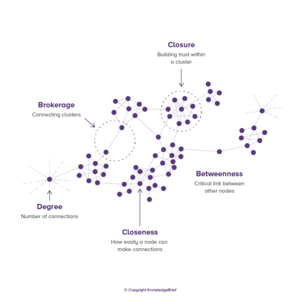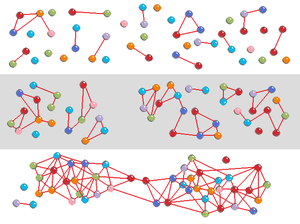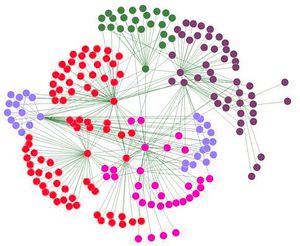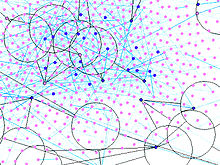Social Network
A Social Network is a website that brings people together to talk, share ideas and interests, or make new friends. Social networks help people keep connected with their friends and family and are an easy way to find what everyone is up to each day in your social circle. Social networks can also be used to find fun and interesting things on the Internet since often your friends and family will share many of the same interests as you.[1]
A social network is defined as a chain of individuals and their personal connections. Expanding one’s connections with other people is a technique that can be used both for personal or business reasons. Social networking applications make use of the associations between individuals to further facilitate the creation of new connections with other people. This could be used to meet new friends and connect with old ones, as many people do on Facebook, or to expand one’s professional connections through a business network like LinkedIn. Social networking is based on the concept of "six degrees of separation," wherein any two people can make contact by a chain of, at most, five mediators. This means that at any given time, each person in the world is connected through a link of five people, making social networking a very powerful tool for spreading or obtaining information. Connections are made possible when a person starts to invite people as contacts. When the invited person accepts the request, the inviter can then invite the invitee's personal contacts, further expanding the network as the cycle continues. Through social networking, interrelated cyber communities can be created in order to help individuals find contacts that may be useful to them but otherwise may be very unlikely for them to meet. With the popularity of social networking sites, more and more people can become part of an online community. They will be able to make new friends as well as share their lives online from wherever they're located.[2]
History and Evolution of Social Network[3]
The first seed of what could be considered as a social network was planted several decades ago. In 1971 the first sending of an email was made through two computers that were side by side. It was done by Ray Tomlinson. Later, in 1978, BBS (Bulletin Board System) was exchanged through telephone lines with other users. Also, the first copies of Internet browsers were distributed during the same year through the Usenet platform. Years later, in 1994, what could be considered one of the first social networks, GeoCities, was launched for the first time. However, the original idea of this space, which later had its clone in Tripod and Spain in Ciudad Futura, Demasiado.com, and Galeón, which is still active, was a service for creating simple web pages that lodged in certain neighborhoods according to their content. A year later, in 1995, TheGlobe.com came to light. This social network provided the opportunity for its users to personalize their own online experiences by publishing their content and interacting with other people who had similar interests. That same year Classmates appeared, a website that helped people find their former classmates and work. Two years later it was time for SixDegrees. A space that some researchers consider as the first social network. Or at least the one that best reflects the definition of social networks. In fact, SixDegrees offered the possibility of creating personal profiles, inviting friends or visiting the profiles of other users. However, all these social networks were far from becoming relevant spaces on the Internet in an era dominated by directories such as Yahoo or search engines such as Altavista. On the other hand, it was the year 1997 when Instant Messenger was launched for the first time. An instant messaging program created by Microsoft Windows with which users could find the most basic chat services and contact list. He can be considered the precursor of one of the most influential social networks currently, the WhatsApp instant messaging service. The downturn of many technology companies that had developed under the protection of the economic bonanza that was closed with the pinch of the dotcom bubble made it look like it was going to break the growth dynamics of the internet. However, it caused the appearance of new startups that were going to be part of the history of social networks. However, it was until 1991 that Tim Berners Lee invents the HTML language, one of the essential elements to make web browsing accessible and straightforward. Already entering the 21st century, more precisely in the year 2002, Friendster was launched for the first time with an apparent objective: to meet new people from different circles of friends. This fact established a greater confidence between the users since they were known of their own friends. Friendster proved to be a very successful formula and reached three million users in the first months of its appearance. A year later, in 2003, the social network that would lead to a new stage was inaugurated: My Space. This new social network was more interactive than those that had arisen until now. In MySpace you could manage from personal profiles to hosting services for photos, comments or followers, all intensely focused initially on music groups. In countries like the United States, many indie bands used My Space to share their work, contacting directly and continuously with their fans. The social network soon understood that it had great opportunities in this regard and encouraged these practices, offering artists space where they could promote themselves. My Space spread mainly in the United States, but in other countries, other services also began to appear with great success such as Orkut, one of the first social network attempts that Google created, in Brazil, Hyves in Holland or Mixi in Japan. Even so, the first social network that had figures of gigantic users was MySpace although its case is a clear example of how a tool of this type can go from being the queen of the dance to almost disappearing. Such learning for many in the history of social networks. The advent of social networks such as LinkedIn or Flickr and spaces such as Digg, WordPress or YouTube predicted a seismic on the Internet that was known until then. Yes. In 2004 one of the most extensive social networks was created so far, Facebook. This new social network did not take long to overcome My Space as a leader regarding monthly visitors. Such was its success that My Space had to modify its strategy and finally established a new design presenting itself as an entertainment platform and not a social network. Facebook, created by Mark Zuckerberg, originated initially with the goal of connecting the university students of Harvard. In fact, more than half of the students of the university subscribed in its first month of operation. A year after its launch, Facebook already had a presence in some 500 American universities with more than 2 million users. In 2006 Facebook became a service open to the public. What radically changed the history of social networks. The companies also saw the great opportunity that this new service offered to advertise and get closer to their audience. Currently, this social network is recognized as one of the most important of all time. In fact, it is still the social network with the highest number of users: 1,650 million active monthly users, as of April 27, 2016. And growing. Two years later, in 2006, Twitter was born. A spin-off of Odeo, the business adventure in which the creators of Blogger had embarked after their purchase by Google. Jack Dorsey, Evan Williams, and Biz Stone created a tool that was born as an internal messaging system to give news but that changed the way in which television is watched or, even, the revolutions are managed. Twitter’s limits, 140 characters since they followed SMS communications, made great the idea of a microblogging network. Today there is no world-class event that is not tweeted. A milestone in the history of social networks.
In recent years, more and more social networks have been appearing that are popularized in niche audiences with different characteristics. Some of the social networks of the last five years are:
- Pinterest. It is a platform to share images among users. They are organized around personal boards by subjects where they collect images according to different events or hobbies.
- Tumblr. It is a microblogging platform that allows users to publish texts, videos, images, links or quotes.
- Youtube. A website where users can upload and share content in the form of video. It hosts millions of music videos as well as television or videoblogs.
- LinkedIn. It is a more specialized social network aimed at companies and businesses. Each user can create a profile where they freely expose their work experience and qualities. In this way, the social network puts millions of professionals in contact with each other.
- Snapchat. This mobile application allows you to send files like images or videos that disappear from the recipient’s mobile device within one to ten seconds after viewing it. All content is submitted through private messages.
Social Network Analysis[4]
The social network analysis (SNA) is a methodology used to analyse the properties of social networks. The way in which the social network is represented is based on Graphs Theory, representing relations as nodes and links, where depending on the level of analysis, the nodes may represent entities such as people, technology, groups or firms (Zack, 2000). O’Reilly and Roberts (1977), and Tichy, Turshman and Fombrun (1979) affirm that SNA is central to the field of structural inquiry and represents an adequate method to analyse groups.

source: KB Manage
Social Networks - Levels of Analysis[5]
In general, social networks are self-organizing, emergent, and complex, such that a globally coherent pattern appears from the local interaction of the elements that make up the system. These patterns become more apparent as network size increases. However, a global network analysis of, for example, all interpersonal relationships in the world is not feasible and is likely to contain so much information as to be uninformative. Practical limitations of computing power, ethics and participant recruitment and payment also limit the scope of a social network analysis. The nuances of a local system may be lost in a large network analysis, hence the quality of information may be more important than its scale for understanding network properties. Thus, social networks are analyzed at the scale relevant to the researcher's theoretical question. Although levels of analysis are not necessarily mutually exclusive, there are three general levels into which networks may fall:
- Micro Level:At the micro-level, social network research typically begins with an individual, snowballing as social relationships are traced, or may begin with a small group of individuals in a particular social context.
- Dyadic level: A dyad is a social relationship between two individuals. Network research on dyads may concentrate on structure of the relationship (e.g. multiplexity, strength), social equality, and tendencies toward reciprocity/mutuality.
- Triadic level: Add one individual to a dyad, and you have a triad. Research at this level may concentrate on factors such as balance and transitivity, as well as social equality and tendencies toward reciprocity/mutuality. In the balance theory of Fritz Heider the triad is the key to social dynamics. The discord in a rivalrous love triangle is an example of an unbalanced triad, likely to change to a balanced triad by a change in one of the relations. The dynamics of social friendships in society has been modeled by balancing triads. The study is carried forward with the theory of signed graphs.
- Actor level: The smallest unit of analysis in a social network is an individual in their social setting, i.e., an "actor" or "ego". Egonetwork analysis focuses on network characteristics such as size, relationship strength, density, centrality, prestige and roles such as isolates, liaisons, and bridges. Such analyses, are most commonly used in the fields of psychology or social psychology, ethnographic kinship analysis or other genealogical studies of relationships between individuals.
- Subset level: Subset levels of network research problems begin at the micro-level, but may cross over into the meso-level of analysis. Subset level research may focus on distance and reachability, cliques, cohesive subgroups, or other group actions or behavior.

Self-organization of a network, based on Nagler, Levina, & Timme, (2011)
- Meso Level: In general, meso-level theories begin with a population size that falls between the micro- and macro-levels. However, meso-level may also refer to analyses that are specifically designed to reveal connections between micro- and macro-levels. Meso-level networks are low density and may exhibit causal processes distinct from interpersonal micro-level networks.
- Organizations: Formal organizations are social groups that distribute tasks for a collective goal. Network research on organizations may focus on either intra-organizational or inter-organizational ties in terms of formal or informal relationships. Intra-organizational networks themselves often contain multiple levels of analysis, especially in larger organizations with multiple branches, franchises or semi-autonomous departments. In these cases, research is often conducted at a workgroup level and organization level, focusing on the interplay between the two structures. Experiments with networked groups online have documented ways to optimize group-level coordination through diverse interventions, including the addition of autonomous agents to the groups.
- Randomly distributed networks: Exponential random graph models of social networks became state-of-the-art methods of social network analysis in the 1980s. This framework has the capacity to represent social-structural effects commonly observed in many human social networks, including general degree-based structural effects commonly observed in many human social networks as well as reciprocity and transitivity, and at the node-level, homophily and attribute-based activity and popularity effects, as derived from explicit hypotheses about dependencies among network ties. Parameters are given in terms of the prevalence of small subgraph configurations in the network and can be interpreted as describing the combinations of local social processes from which a given network emerges. These probability models for networks on a given set of actors allow generalization beyond the restrictive dyadic independence assumption of micro-networks, allowing models to be built from theoretical structural foundations of social behavior.
- Scale-free networks: A scale-free network is a network whose degree distribution follows a power law, at least asymptotically. In network theory a scale-free ideal network is a random network with a degree distribution that unravels the size distribution of social groups. Specific characteristics of scale-free networks vary with the theories and analytical tools used to create them, however, in general, scale-free networks have some common characteristics. One notable characteristic in a scale-free network is the relative commonness of vertices with a degree that greatly exceeds the average. The highest-degree nodes are often called "hubs", and may serve specific purposes in their networks, although this depends greatly on the social context. Another general characteristic of scale-free networks is the clustering coefficient distribution, which decreases as the node degree increases. This distribution also follows a power law. The Barabási model of network evolution shown above is an example of a scale-free network.

Social network diagram, meso-level
- Macro level: Rather than tracing interpersonal interactions, macro-level analyses generally trace the outcomes of interactions, such as economic or other resource transfer interactions over a large population.
- Large-scale networks: Large-scale network is a term somewhat synonymous with "macro-level" as used, primarily, in social and behavioral sciences, in economics. Originally, the term was used extensively in the computer sciences.
- Complex networks: Most larger social networks display features of social complexity, which involves substantial non-trivial features of network topology, with patterns of complex connections between elements that are neither purely regular nor purely random, as do biological, and technological networks. Such complex network features include a heavy tail in the degree distribution, a high clustering coefficient, assortativity or disassortativity among vertices, community structure , and hierarchical structure. In the case of agency-directed networks these features also include reciprocity, triad significance profile (TSP), and other features. In contrast, many of the mathematical models of networks that have been studied in the past, such as lattices and random graphs, do not show these features.

Diagram: section of a large-scale social network
See Also
Social Networking
Network Effect
Social Media
Social Media Governance
World Wide Web (WWW)
Internet
Internet of Things (IoT)
Internet Reputation
Internet Privacy
Industrial Internet of Things (IIoT)
Search Engine
Search Engine Optimization (SEO)
References
- ↑ Defining Social Network Computer Hope
- ↑ Explaining a Social Network Techopedia
- ↑ History and Evolution of Social Network Antevenio
- ↑ Social Network Analysis KBManage
- ↑ Social Networks - Levels of Analysis Wikipedia
Further Reading
- Analysis of Social Network Sites and Supporting Functions Rebecca Anderson
- The Role of Social Networks in Community Engagement ATSDR
- A Practical Guide to Social Networks HBR
